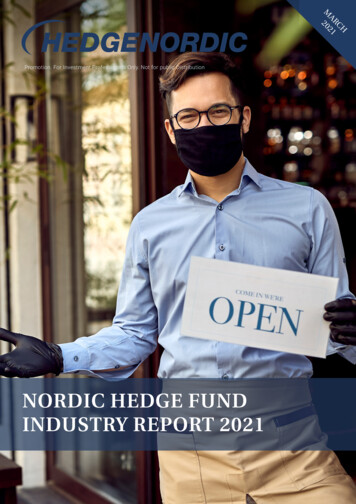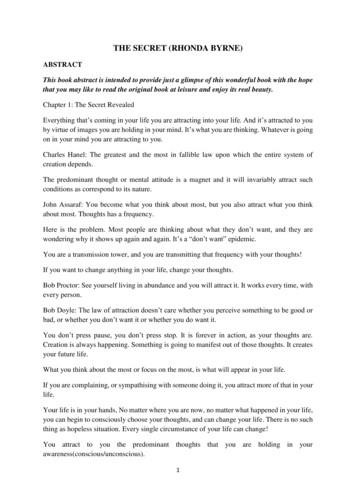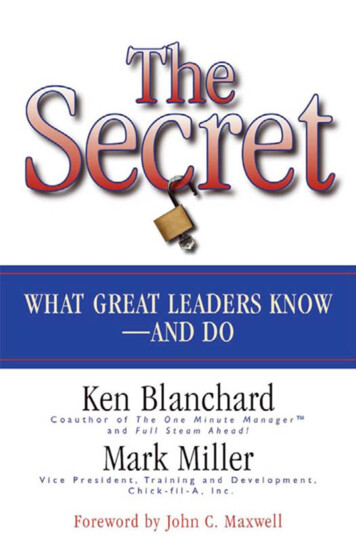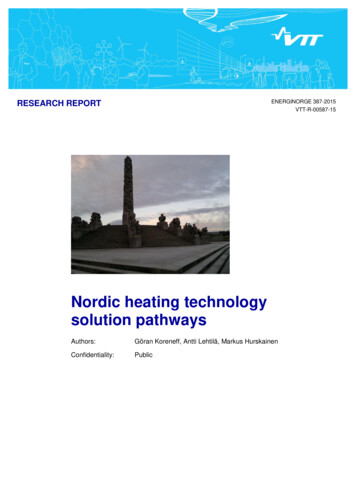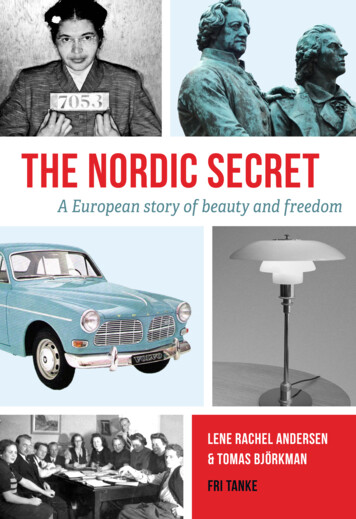
Transcription
the nordic secretA European story of beauty and freedomlene rachel andersen& tomas björkmanfri tanke
Lene Rachel Andersen and Tomas BjörkmanTHE NORDIC SECRETA European Story of Beauty and Freedom
THIS EXCERPTCONTAINSTHE PREFACE,THE INTRODUCTION,THE FIRST PAGEOF ALL CHAPTERSAND THE INDEXThe Nordic Secret16
COLOPHONFri Tanke förlagwww.fritanke.seinfo@fritanke.seCopyright Lene Rachel Andersen and Tomas Björkman 2017www.nordicsecret.orgDesign coverfront: Miroslav SokcicDesign cover and content: petitbureau.dkPrint: Scandbook, Falun 2017Primary ISBN: 978-91-87935-96-1Danish ISBN: 978-87-92240-74-3 – Det Andersenske ForlagCover photos:Rosa Parks booking – Wikimedia CommonsGoethe and Schiller statue: Ad Meskens / Wikimedia CommonsVolvo: years.phpPH-Lamp: Holger Ellgaard / Wikimedia CommonsStudy circle
BY THE SAME AUTHORSLene Rachel AndersenBaade-Og Mandag (2005)Grantræet (2005)Baade-Og Tirsdag (2006)Baade-Og Onsdag (2007)Baade-Og Torsdag (2008)Baade-Og Fredag (2009)Demokratihåndbog (2010) / www.democracy-handbook.org (2010)Det åbne samfund og dets venner (2011)Fire uetiske mænd i sengen (2013)Danmark 2030 (2013)Globalt gearskift (2014)Testosteroned Child. Sad. (2017)Fremtidens velfærd (2017)Tomas BjörkmanThe Market Myth (2016)Världen vi skapar (2017)
ContentsPreface 1Introduction and overview 7PART I – Setting the scene 17Chapter 1: Are the Nordic countries really that remarkable? 19Chapter 2: Personal freedom and responsibility – psychology 33PART II – Personal freedom and responsibility – Bildung philosophy 63Chapter 3: A very different kind of Europe 65Chapter 4: The Bildung prelude 77Chapter 5: The German Spring Chapter 6: Bildung and ego-development PART III – The Scandinavian Spring – implementing Bildung 99163171Chapter 7: The Danish Spring 175Chapter 8: The Norwegian Spring 227Chapter 9: The Swedish Spring 245Chapter 10: Summing up the Scandinavian spring – folk-Bildung 1.0 271Chapter 11: The Modern Spring – folk-Bildung 2.0 275PART IV – Exploring what we have found 307Chapter 12: What happened elsewhere? – Control cases 309Chapter 13: Does our thinking hold up? 331Chapter 14: Scandinavia today – self-destruction in the making 347Chapter 15: What we have discovered writing this book 359
PART V – Looking forward 379Chapter 16: Can the Nordic experience benefit the rest of the world? 381Chapter 17: Societal transitions 393Chapter 18: Where are we now? – Challenges, obstacles and choices 409Chapter 19: What could Bildung and folk-Bildung 3.0 look like? 435Chapter 20: Looking forward to our conversations 461Appendix 466Sources 471Index 480
PREFACEA European story of beauty and freedomWe humans generally do not solve the problems we have; we solve theproblems we understand—if we have a sense that they are our problems tosolve. What sometimes happens, though, is that we face a new problem andsee it as our problem to solve, but do not understand the complexity of itand rather than solving one problem, we create a new one.Short of a meteorite hitting Earth, the problems we face as a species areproblems we have created ourselves. Climate change, overpopulation, poverty, pollution, wars, terrorism; you name it, we created it. Ironically, whatcreated many of these problems was once the solution to something else.The good news is that the knowledge to solve our problems is available;the bad news is that we need to understand more in order to do somethingabout it. We also need a sense of responsibility. We need consciousness andconscience.The biggest problems we face are very complex and therefore we need tounderstand our own world at a higher level of complexity.What is needed is a systems perspective: the ability to see systems within systems. The ability to see the big patterns in the affairs of the world plusthe ability to zoom in on the details and out to the full picture of interactingsystems. Not many people have this kind of complexity of mind but almostall of us have the potential.The Nordic countries (Denmark, Finland, Iceland, Norway, and Sweden)look as if we have it all figured out: stable societies, high levels of individualfreedom, low levels of corruption, the world’s happiest people, functioningThe Nordic Secret1
public institutions, public welfare systems that cover health care for everybody, free education from primary school to master’s degree, high standardsof living, best climates for business, high levels of trust, and much more.That cornucopia of good-country qualities came from developing andusing everybody’s potential. It came from leaders who had a systems perspective on our countries and from voters who were qualified to elect themand did elect them. Our countries were developed by populations amongwhom a critical number of people could see the nation as a whole, caredabout the totality and elected leaders with the same big, yet detailed picturein mind. We know that this is a strong claim but it is part of the Nordic secret, and we have written this book to show what we mean by it.Having grown up in Denmark and Sweden, respectively, we can confirmthat all of the above-mentioned good-country qualities were there for uswhen we grew up and that coming of age in such a secure, supporting andgenerous environment is a blessing. Our grandparents were farmers, ourparents were suburban middle class and all we had to do was to decide howwe wanted to make the most of it. With a bit of personal effort, we could enterour adult lives well-educated, debt-free and confident that the system wasworking and would help us if something went wrong.We are writing this book for three reasons:We are convinced that the way the Nordics allowed everybody to develop their potential can be copied anywhere. After all, once the necessary knowledge about human potential and development was available,the teaching and learning method was invented by a pastor, a teacher andsome farmhands. It then went viral by people’s own initiative. That couldhappen again.The knowledge and method were developed as Europe went throughthe transition from feudal agricultural absolute monarchies to modern industrialized democracies, and it allowed the peoples of the Nordics to findthe transition meaningful and to make it peacefully and prosper from it.Instead of waging wars, our ancestors built institutions and welfare statesmatching the needs of industrialized societies. As a species, we humans arecurrently in a new transition from industrialized nation states to a digitalglobal economy—some are even making this transition from a pre-modern, nonindustrialized starting point. Not only do we need new institutions2preface
again, the transition also needs to be meaningful to people and give themhope, or else they will wage wars.Our third reason for writing this book is deep frustration: the Nordiccountries, which made the previous transition so well, are not gearing upfor the current challenges. What we see are some Nordic countries thatonce were extremely poor, that developed the best possible solutionsduring the industrial age and became rich in every possible way, and thatare currently destroying their own success. We see that several institutions do not work properly anymore and that there is no institutional orpolitical will nor skill to develop the next generation of institutions thatcan handle the challenges of the 21st century. We are facing problems thatour political systems do not understand, therefore we are not developingadequate solutions.Instead, “McKinseyism” is taking over politics; consultants who willnever be held accountable by the voters make expensive reports that areturned into legislation by politicians who then claim that they made thewisest decision possible when they implemented what the consultants recommended. Somehow, the reports always recommend privatization andinstead of upgrading and reinventing crucial infrastructure, institutionsthat keep our countries working are sold off to the highest bidder. Whileordinary people fear globalization and immigration and long for nationalidentity and security, politicians are selling our family silver. What wereonce nations with a vision are reduced to corporate landmasses with competing workforces.Politicians and activists around the globe are looking towards the Nordicsbecause we look like we have it figured out. That used to be true, but not anymore.The Nordics’ historical experience is worth learning from nevertheless: we Nordics figured out how to develop and use everybody’s potential,and humanity needs that all around the globe more than ever. Our pointwith this book is not to brag about the Nordics. Our aim is to tell an amazing story about freedom, beauty and successful, meaningful change.So how did the Nordics become successful in the first place? How didwe develop our potential? What is our secret and can other countries learnfrom it? In the 1800s, the Nordic countries were among the poorest in Europe; Sweden was so poor that orphans were auctioned off as cheap labor.The Nordic Secret3
When we started out researching and writing this book, we thought wehad a good idea, that we had found something important, and that we couldinitiate a different kind of political debate. As we kept researching, we realized that there was a Nordic, European and American story about how andwhy our democracies and freedoms evolved that had never been told. Wealso found more historical evidence for our hypothesis than we had everimagined. What started out as a short debate book soon turned into solidacademic research and we decided that we wanted to share the core elements of what we found; partly because it is a fascinating story, and partlybecause it helps us understand how prosperity and good societies are created. But most of all, because humanity faces complex problems and morepeople need to be able to understand them so that we can solve them. Understanding the sources of our societal and political development of thepast 250 years, causes a cultural fabric to stand out that explains why somecountries work so well. The sources hold the key, and they are not entirelyNordic, they are British, French, German, and Swiss with some importantinput from Greece, Italy, Moravia (in today’s Czech Republic), and the United States. Not only did this shape Europe, it shaped the United States too.This is a tale of trans-Atlantic beauty and freedom.With this book, we hope to reach four main groups of readers who usually do not read the same books—which is exactly one of the problems weface today: echo chambers of insufficient knowledge. The four groups are: People in fields related to politics and economics.People in fields related to human development.People in fields related to literature and the arts.Citizens who engage in their society, be it as politicians, volunteers,party members, or voters looking for new perspectives.Given this diverse target group of readers, some will probably wonderabout parts of this book: Why do I need to know this about Rousseau andHerder? Why must I look at GDP per capita? Why so many quotes from Schiller? Is this Danish king really that relevant, I’m not Danish! How can this oldstuff be relevant in the 21st century? and so forth Others may read with a different kind of wondering: How come I never4preface
knew this connection before? Why were history lessons in school not aboutthis? Is my country’s economy actually dependent on philosophy? Whatwould a similar development or institution look like today? Where could myknowledge make a difference? Who would be the best people with whom todiscuss this?Given the diverse target group of readers, we have chosen to prioritizea good reading experience over academic documentation and footnotes inthe book itself. Instead, main sources are mentioned in the text, there is aliterature list at the end of the book, and all our sources including usefullinks are online /On nordicsecret.org, you will also be able to participate in discussions,share comments and help us with extra and/or conflicting documentation.When we had written the first draft, we sent it to about 100 Europeanand American researchers, policy makers and people in the arts in order toget feedback and suggestions for improvement. We also held three roundtables in Berlin, Leiden and Stockholm in order to start a research-basedEuropean conversation about human and societal development in the 21stcentury.For feedback, input and big thoughts, we would like to thank: Michel Alhadeff-Jones, Dan H Andersen, Bo Andersson, Lars Andreassen, Richard Bell,Sturla Bjerkaker, Lars Thorkild Bjørn, Mette Hvid Brockmann, Jos van denBroek, Arthur Brühlmeier, Anders Burman, Michael Bøss, Paul Cobben, LarsDencik, Peter Duetoft, Kristina Elfhag, Tobias Etzold, Merel van Geel, RasmusGlenthøj, Dick Holmgren, Thomas Jordan, Bent Raymond Jørgensen, FlemmingJørgensen, Arthur Kok, Teddy Hebo Larsen, Jeroen Lutters, Kyra Mensink, Marijn Moerman, Jo Moran-Ellis, Jonathan Reams, Beate Richter, Myrte Rischen,Jonathan Rowson, Ginie Servant, Heinz Sünker, Eugene Sutorius, Michiel Tolman, Ad Verbrugge, Ole Vind, Jan Visser, Christian Welzel, Koen Wessels, Matilda Westerman, Gunnar Wetterberg, Michael Winkler, Oliver Zöllner, and JensØstergaard.The Nordic Secret5
Tomas also wants to thank Lene for being the strong and tireless engineof this book project, putting in the bulk of the hard work required as theproject grew beyond our original plans.Lene would like to thank Tomas for inspiring and fruitful discussions,disagreements, work sessions, and hour-long phone calls. This has been somuch fun.We were personally fortunate to grow up in societies that had the highest hopes for us and provided us with life skills that gave us unique opportunities. We see no reason why not everybody on the planet should havethe same opportunities and access to the same kind of meaningful and fulfilling life and freedom. Further, we are convinced that were everybody toenjoy similar opportunities, we would be able to solve our problems, createa sustainable global economy, and not just save the environment but develop a flourishing planet.We appreciate the cultural diversity and different traditions around theglobe. Our Nordic secret might help strengthen this diversity and promotea global appreciation of it as well as make the local roots deeper. We hopethat we can inspire structural change and human progress, not culturalimperialism or a global mono-culture. We hope that the Nordic secret canenable people to keep and develop their local cultural heritage and helpthem find more meaning and purpose in a rapidly changing world.So, what is this secret all about? What do we mean by mental complexityand developing everybody’s potential? What exactly is a systems perspective and how does one get one?We hope that you will enjoy finding out.Lene Rachel Andersen & Tomas Björkman6preface
INTRODUCTIONAND OVERVIEWWe are going to go on quite the journey, historically, culturally, academically, intellectually, and—perhaps—emotionally. So, before we start, let us introduce what we areabout to do.We are going to make the case that the success of the Nordic countries—not least the successful transition from poor agricultural to rich industrialized countries—was due to a very specific and targeted political project:key cultural and political figures in the 1800s saw the need for enculturation and personal emancipation of the rural population. Visionary pastors,intellectuals, authors, politicians, and some aristocrats and royals saw thatthe feudal structure was about to collapse, that there was a mass-migrationto the cities, and that the sharecroppers, peasants, farmers, and later theworkers too, needed more than reading and writing skills if they were to become responsible citizens.The general population, including farmhands, unskilled workers andwomen outside the city bourgeoisie, needed to be more than a workforce;they had to be responsible persons who cared about their country andcould engage in their society. In order to do that, they needed to identifywith their nation and they needed a sense of collective identity as a people. Around 1800, the majority of the population would mainly have identified with their family and local village. Their pastor and their landownerwould have been their local authority and they would have viewed the kingas some strict father figure far away, but they would not have had much ofThe Nordic Secret7
an idea about other people like themselves living in other parts of their owncountry.In order for all these people to develop that kind of identification andnational loyalty and cohesion, they needed a richer and more complex inner world. They needed to develop a sense of responsibility towards self andsociety; they needed moral, emotional and cognitive development. Theyneeded what is called ego-development in modern psychological terms.When we express it like that, it sounds like a very strange claim, especially given that we claim that this was a political project 150-200 years ago.Nevertheless, this is the case we are going to make: there was an understanding of the human mind in the 1800s that was surprisingly “modern”but has been overlooked and lost, and this understanding was behind deliberate political efforts that actually worked. The key is that rather than psychological or ego-development, people back then called it something else.In the top layers of the Nordic societies, there were people who saw thelack of mental complexity, discussed it and wrote about it; there was anawareness that the common people were not ready for the changes their society was going through and that something had to be done about it. Some ofthe intellectuals were quite explicit about the people not having the necessary knowledge, self-confidence and mental complexity to match the challenges of the 1800s. They used a very different—and in some cases not verypolitically correct—vocabulary about the lower classes, but that was whatthey meant. They wanted the people to think, feel and act in different ways.But here is the interesting and significant part: though they wanted to promote feelings of responsibility and peoplehood, they did not want to dictatewhat the people should think or how they should act. They wanted a population that could “author” their own lives and take part in the authoring ofa new society. What they wanted was a general population that could thinkfor itself and disagree at a higher level.The inspiration came from the United Kingdom, Germany, the United States, France, and Switzerland. The philosopher Shaftesbury inspiredcontinental philosophers throughout the 1700s, Goethe sparked Sturmund Drang in 1774, and the American Declaration of Independence in 1776raised hopes of emancipation in Europe as well. The French Revolution in1789 inspired intellectuals across Europe to hope for political freedom like8Introduction and overview
in the United States, but the following bloodbath appalled everybody andthe disappointment was tangible.With the hopes of political freedom thus in shambles, the German thinkers developed Romanticism in the 1790s, the Napoleonic wars sparked nationalism around 1810, and that all gave birth to Romantic Nationalism,which became a major cultural factor as of the 1810s. Contrary to the Germans, the Swiss pedagogue Pestalozzi wrote openly about societal changesand his focus was pedagogy and how to empower the poor through education.What emerged was the understanding that people must be able to control their emotions, internalize the norms of society and take individualmoral responsibility. In German, this kind of personal ego-developmentgoes under the name Bildung.The reading and writing classes in the Nordics were inspired by this Idealism, Romantic nationalism and Bildung philosophy, and Bildung becamethe new black. But the German thinking was much too lofty to capture peasants who lacked what would today be called cultural capital. These wereGod-fearing, pragmatic, rural people who only read their Bible, the hymnbook and Luther’s Catechism. To reach these peasants, several efforts hadto come together. First, the Danish school system was transformed by progressive legislation, then poets ignited nationalism, and eventually a cleverpastor added some English pragmatism to the cocktail in order to bring thelofty German ideals down to earth and into practice.Strange as it may sound, the hopes of the American and French Revolutions, the Romantic nationalism of the German Idealists and the industrious pragmatism from the UK all came together in a farmhouse on the smallDanish island of Funen in 1851. The aforementioned clever pastor was oneof the financial as well as intellectual sponsors, and the people who madethe big breakthrough were a stubborn teacher and some 18-year-old farmhands. What they had just invented was deliberate ego-development and itcame to be known as folk-Bildung. A path had been invented towards developing everybody’s potential.As a result, over the next 100 years, the Nordics were transformed peacefully from dirt-poor farming countries to some of the richest industrializedcountries in the world. It is an amazing story and we so much enjoy telling it.The Nordic Secret9
Our hypotheses and questionsTwo things got us started writing this book: first a suspicion that therewas an overlap between ego-development as it is described by currentdevelopmental psychology and the old concept of Bildung; second, a rather strong assumption, yet only vague knowledge, regarding the impact offolk-Bildung in the Nordic countries. As we started exploring the development of the concept of Bildung and the folk-Bildung of the Nordics, we eventually worked from the following five hypotheses and nine questions:1. The modern concept of ego-development is more or less the same asthe old concept of Bildung; If this is true, how close are they in fact to one-another?2. Folk-Bildung is different from mere adult education; How much of a difference is there?3. Folk-Bildung has played a significant part in the development of theNordic societies as of the mid-1800s; How much of a part did it play? How much of an understanding of the original meaning ofBildung and thus ego-development did the teachers, pastors,politicians and other initiators of folk-Bildung in the Nordiccountries have 150-200 years ago? If the folk-Bildung initiators did in fact understand developmental psychology, how big a part did psychological development play in the development of the modern Nordiccountries?4. The Nordic countries became successful due to a deliberate cultural, intellectual, moral, and emotional cultivation of the least educated part of the population; How deliberate was it? How many people were affected and how?5. There is a universal lesson about creating democracy and stable societies to be learned from the Nordic countries;10Introduction and overview
How can the Nordic experience benefit the rest of the world? Can this historical experience regarding the transition fromfeudal absolute monarchies to industrialized democraticnation states help us in any way as we are going through atransition from the industrialized nation states to a digitized,globalized economy that must somehow become a globalcommunity?The content of this bookWe are writing this book not to brag about our corner of the world but inorder to share some lessons about how to build prosperous and well-organized societies where happy people can live meaningful lives.For practical reasons we are going to focus on the three Scandinaviancountries: Denmark, Norway and Sweden. When we explore the situation inthe Nordic countries today, we are going to look at Iceland and Finland too,but as we go back in history, we are going to narrow our Nordic focus. First,because of the language barrier: neither of us reads Icelandic or Finnish;second, to keep the book as short as possible. We instead use Finland as a“control case” towards the end and hope that the Icelanders and Finns willforgive us.The book comprises five parts and 20 chapters, and they are somewhatdifferent from one another in content as well as in length and style:PART I – Setting the sceneChapter 1: Are the Nordic countries really that remarkable?Facts and statistics about the Nordic countries today.Chapter 2: Personal freedom and responsibility – psychologyContemporary models of human development and meaning-making;what is ego-development?The Nordic Secret11
PART II – Personal freedom and responsibility – Bildung philosophyChapter 3: A very different kind of EuropeWe go back 350 years to find out how Europeans understood the worldbefore they invented Bildung.Chapter 4: The Bildung preludeA handful of philosophers explored our emotions and how our mind works.Chapter 5: The German SpringConcepts of freedom and human development in the late 1700s and the1800s; what is Bildung?Chapter 6: Bildung and ego-developmentTo what extent are they the same? There is quite the overlap but Bildungis more complex.PART III – The Scandinavian Spring – implementing BildungChapter 7: The Danish SpringHow Bildung was turned into folk-Bildung and transformed a country.Chapter 8: The Norwegian SpringHow the Danish invention made it to Norway and got an extra layer.Chapter 9: The Swedish SpringHow German, French and Danish input inspired the Swedes.Chapter 10: Summing up the Scandinavian spring – folk-Bildung 1.0What were the similarities and differences among Denmark, Norwayand Sweden as they developed folk-Bildung?Chapter 11: The Modern Spring – folk-Bildung 2.0Transforming all of Scandinavia after 1880.12Introduction and overview
PART IV – Exploring what we have foundChapter 12: What happened elsewhere? – Control casesHow can we test the importance and results of folk-Bildung when wecannot re-run history?We look at Finland, Switzerland, how bad things went in Germany duringthe Nazi era, the Civil Rights Movement in the United states, Nordic immigrants to the United States, and cooperatives’ contribution to the economyin 19 countries.Chapter 13: Does our thinking hold up?We conclude regarding our hypotheses 2, 3 and 4.Chapter 14: Scandinavia today – self-destruction in the makingWe look at how Denmark and Sweden are dismantling their heritageand success.Chapter 15: What we have discovered writing this bookWe explore some bonus insights that came as a surprise to us. Amongother things, we are rather certain that not only have we found the Nordicsecret, we have also found the Freemasons’ secret—read on PART V – Looking forwardChapter 16: Can the Nordic experience benefit the rest of the world?Some concrete lessons and concluding regarding our 5th hypothesis.Chapter 17: Societal transitionsHow do societies generally transform and become more complex due totechnological development?Chapter 18: Where are we now? – Challenges, obstacles and choicesWhat is actually happening in the world right now due to new technologies?The Nordic Secret13
Chapter 19: What could Bildung and folk-Bildung 3.0 look like?We share a few suggestions for the road ahead.Chapter 20: ConcludingKeeping the conversation going.Folk-Bildung to the rescue—our conclusionIf we are to sum up the Nordic secret, what we have found is the following:Bildung is the way that the individual matures and takes upon him- orherself ever bigger personal responsibility towards family, friends,fellow citizens, society, humanity, our globe, and the global heritageof our species, while enjoying ever bigger personal, moral and existential freedoms. It is the enculturation and life-long learning thatforces us to grow and change, it is existential and emotional depth,it is life-long interaction and struggles with new knowledge, culture,art, science, new perspectives, new people, and new truths, and it isbeing an active citizen in adulthood. Bildung is a constant processthat never ends.Beginning around 1800, visionary pastors, intellectuals, educators, authors, and politicians in the Nordic countries saw that theworld was changing. Around 1850 and particularly as of the 1860s,this was turned into a deliberate agenda: large-scale development ofthe inner self, the ego. The people needed Bildung, a phenomenon thathad been thoroughly explored and described by a number of European thinkers. Particularly the peasants needed to grow and change ifthey were to handle the societal transition, and an educated elite developed the institutions for it. Because it was deeply meaningful andit empowered people, they loved it and they co-created it and took responsibility for it. Whoever participated had fun and got to developtheir potential at their own pace.In the Nordics, we have implemented developmental psychology aimed at changing our ways of carrying ourselves through life. Itemancipated our great-great-(great)-grandparents and until around14Introduction and overview
the turn of the millennium, it raised our expectations of ourselvesand of our political leaders. It allowed our immediate ancestors tohandle the increasing complexity and to develop healthy institutionsand thriving societies. It also allowed them to develop a healthy nationalism that did not turn into national chauvinism but allowed forhigh levels of responsibility and trust. And that is the Nordic secret:folk-Bildung.The Nordic Secret15
PART ISetting the sceneAbout the Nordics todayand an exploration of ego-development;what is it?
Chapter 1ARE THE NORDICCOUNTRIES REALLYTHAT REMARKABLE?part IFacts and statistics about the Nordic countries today; whyare the Nordics worth exploring in the first place?How remarkable are the Nordic countries? Really? Are we just self-promoting “Nordicists” running an errand for our national tourist departments, or is there somet
The Nordic Secret explores how the Nordic countries invented a new kind of education, developed everybody's potential and changed their fate. The inspiration came from Germany, France, Switzerland, the US, and the UK, and the transition began in a farmhouse. As new technologies and globalization are revamping




